Cyberbullying Statistics, Facts, and Trends (2023) with Charts

Sadly, bullying behavior has been around since the beginning of civilization. Bullying has consistently taken form as stronger people preying upon the weak, and now, with the rise of technology, it has also become widespread online.
Cyberbullying has become a growing problem in countries around the world. Essentially, cyberbullying doesn’t differ much from the type of bullying that many children have unfortunately grown accustomed to in school. The only difference is that it takes place online.
Below are a number of concerning cyberbullying statistics that show the scope of this rising problem, and the need for an effective solution.
The most interesting cyberbullying facts
- The most common types of online bullying are rumors spread online (33.2%) and mean comments (28.7%).
- 35% had shared a screenshot of someone’s status or photo to laugh at them.
- 61% of teens who report being bullied say it was because of their appearance.
- 41% of US adults who use the internet have personally experienced online harassment.
- 77% of online harassment victims reported that they had been harassed on Facebook.
- 7 in 10 young people experience cyberbullying before they hit the age of 18.
What counts as cyberbullying?
If you’ve ever seen the TV host Jimmy Kimmel’s segment “Celebrities Read Mean Tweets,” you will have an idea of what it means to cyberbully someone. Although this segment is humorous, the reality of the situation is very different.
Cyberbullying is any type of harassing, threatening, demeaning language. It can also involve embarrassing another person online. Typically, this is done through mean comments, online rumors, and even sexual remarks. They’re usually connected with appearance, intelligence, race, or sexuality.
Essentially, anything that is posted online that’s intended to hurt or upset someone else, regardless of what the topic is, is considered to be cyberbullying.
1. The most common types of online harassment are rumors spread online (33.2%) and comments (28.7%), according to US students.
Apart from spreading rumors (33.2%), posting mean comments online (28.7%), and posting sexual remarks (12.1%), cyberbullies among US students commonly use aggressive and pejorative words, threats, profile hacking, and photo-sharing without consent.

(Source: Cyberbullying.org)
2. 64% of victims who receive an aggressive instant message say they know the perpetrator from in-person situations.
Even when they personally know their victims, perpetrators often resort to annoying, upsetting, and embarrassing them online, mostly by mocking their photos or status updates in group chats (35%). Perpetrators can also troll victims in an online game (25%).

(Source: Verywellfamily.com)
3. Nearly 1 in 6 (15%) of online teens said they had experienced unwanted forwarding of private communication.
18% of teens aged 15-17 and 11% of younger teens have experienced their bullies sending their private messages to others or sharing them on public channels.
(Source: Pewresearch.org)
4. Teens (61%) who report being bullied say it was because of their appearance.
Personal appearance (61%) seems to be the most common reason for cyberbullying, followed by intelligence (25%). Racism (17%) and sexual discrimination (15%) are also frequent tools for discrimination, as well as mocking someone because of their financial difficulties (15%) and religion (11%).

(Source: Nveee.org)
5. Bullies often target victims with disabilities and mental illnesses..
It’s easier to bully someone weaker. Someone who can’t fight back. That’s why bullies often harass someone who is dealing with a mental illness or has a disability.
(Source: Ditchthelabel.org)
6. Recent statistics show steady growth in cyberbullying trends.
Between 2007 and 2016, the number of teens experiencing cyberbullying had remained almost the same (32%+-). In 2019 cyberbullying statistics, nearly 43% of teens (mostly girls and LGBTQ community members) had experienced some form of online harassment.
(Source: Statista.com)
7. 41% of US adults who use the internet have personally experienced online harassment.
Close to half of US adults (41%) who use the internet have dealt with cyberbullying, with 27% reporting severe online harassment, including physical threats (18%), sexual harassment (12%), stalking (13%), and sustained harassment (12%).
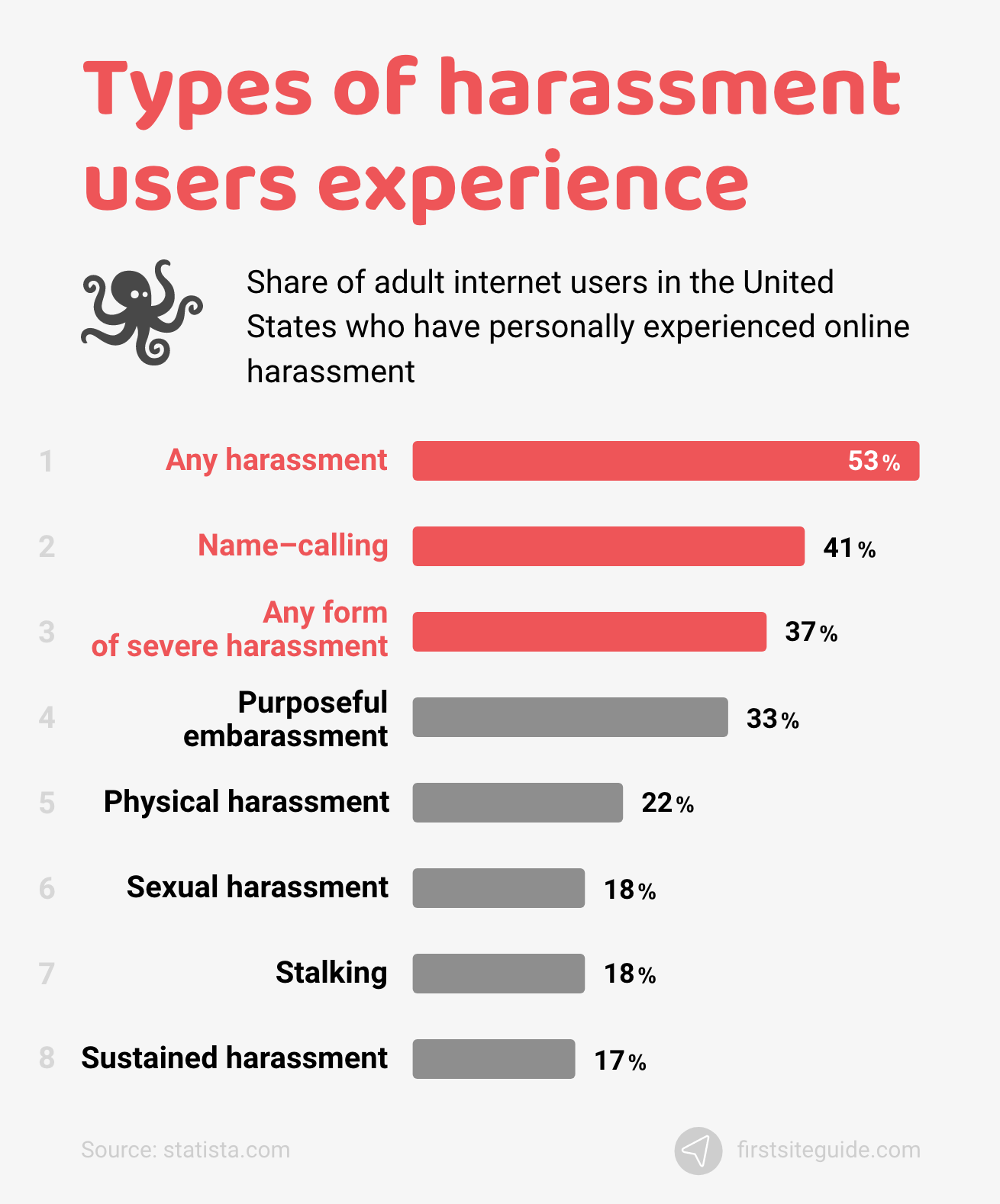
(Source: Statista.com)
8. 77% of online harassment victims reported that they had been harassed on Facebook.
This definitely doesn’t come as a surprise, given that Facebook is the dominant social media platform, counting nearly 2.85 billion monthly active users, 1.8 billion of whom are US users.
(Source: Statista.com)
Who is prone to cyberbullying?
While cyberbullying is mostly associated with school children, they aren’t the only targets, and many adults experience cyberbullying themselves.
The most common target for cyberbullies are children, young adults (especially girls), students, and members of the LGBTQ community.
As far as the bullies themselves are concerned, they come from all walks of life. Studies show that children with less involved parents and those suffering from depression or anxiety tend to display bullying behavior, but nothing’s conclusive as of yet. To better illustrate these trends, the following cyberbullying graph provides an insightful visual representation.
9. Girls are more likely than boys to be both victims and perpetrators of cyberbullying.
Only 6% of boys reported being bullied online, compared to 15% of girls, particularly older girls aged 12-17. 41% of older girls reported experiencing some form of online harassment.

(Source: Dosomething.org)
10. 7 in 10 young people experience cyberbullying before they hit the age of 18.
That’s 45% of young and older teens (especially girls and members of the LGBTQ community) who have been victims of cyberbullies. It’s an alarming percentage that seems to be only increasing.
(Source: Ditchthelabel.org)
11. About 37% of children between 12 and 17 years experienced cyberbullying at least once.
Although a great number of young people (60%) had witnessed their peers aged 12-17 (37%) being bullied, they didn’t bother to try and stop the bullying. Most people don’t want to intervene to avoid becoming victims themselves.
(Source: Comparitech.com)
12. From a poll of 20,000, 70% of school students said that someone spread rumors about them online.
This statistic was uncovered by the Florida Atlantic University, in a study of surveys conducted over the past decade. The study also found that 73% of middle and high-school students had experienced bullying on school grounds.
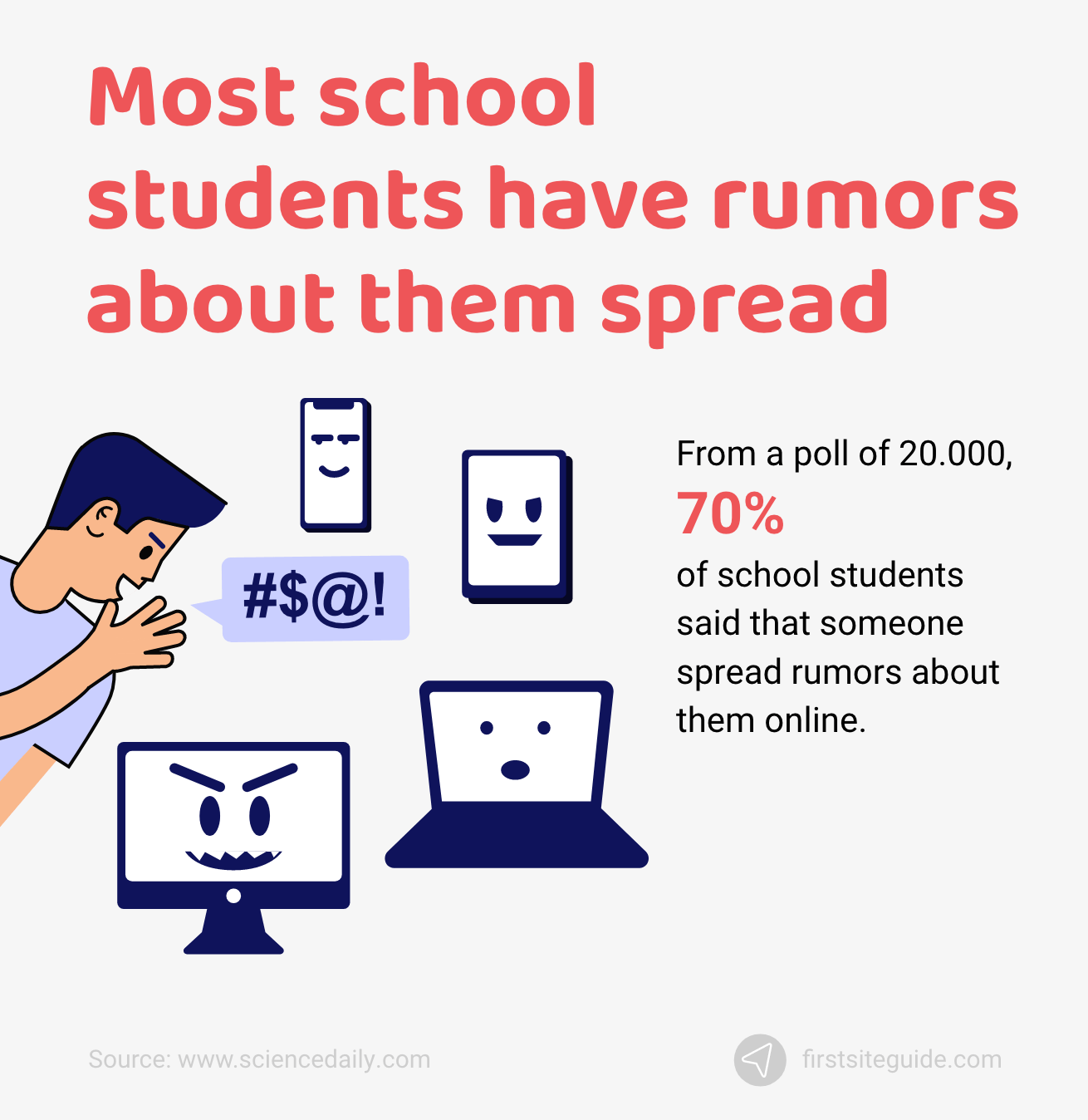
(Source: ScienceDaily.com)
13. More than one in 10 students (12%) admitted to cyberbullying someone else at least once.
This same Florida Atlantic University study found that 12% of respondents confessed that they had bullied someone online at some point in their life. The perpetrators were most commonly boys.
(Source: Florida Atlantic University)
14. Over 12% of LGBT youth have experienced cyberbullying.
LGBT cyberbullying statistics show that LGBT teens are more likely to be bullied than heterosexual teens. More than 12% of LGBT teens reported being cyberbullied, with 58% dealing with hate speech and 35% receiving online threats.
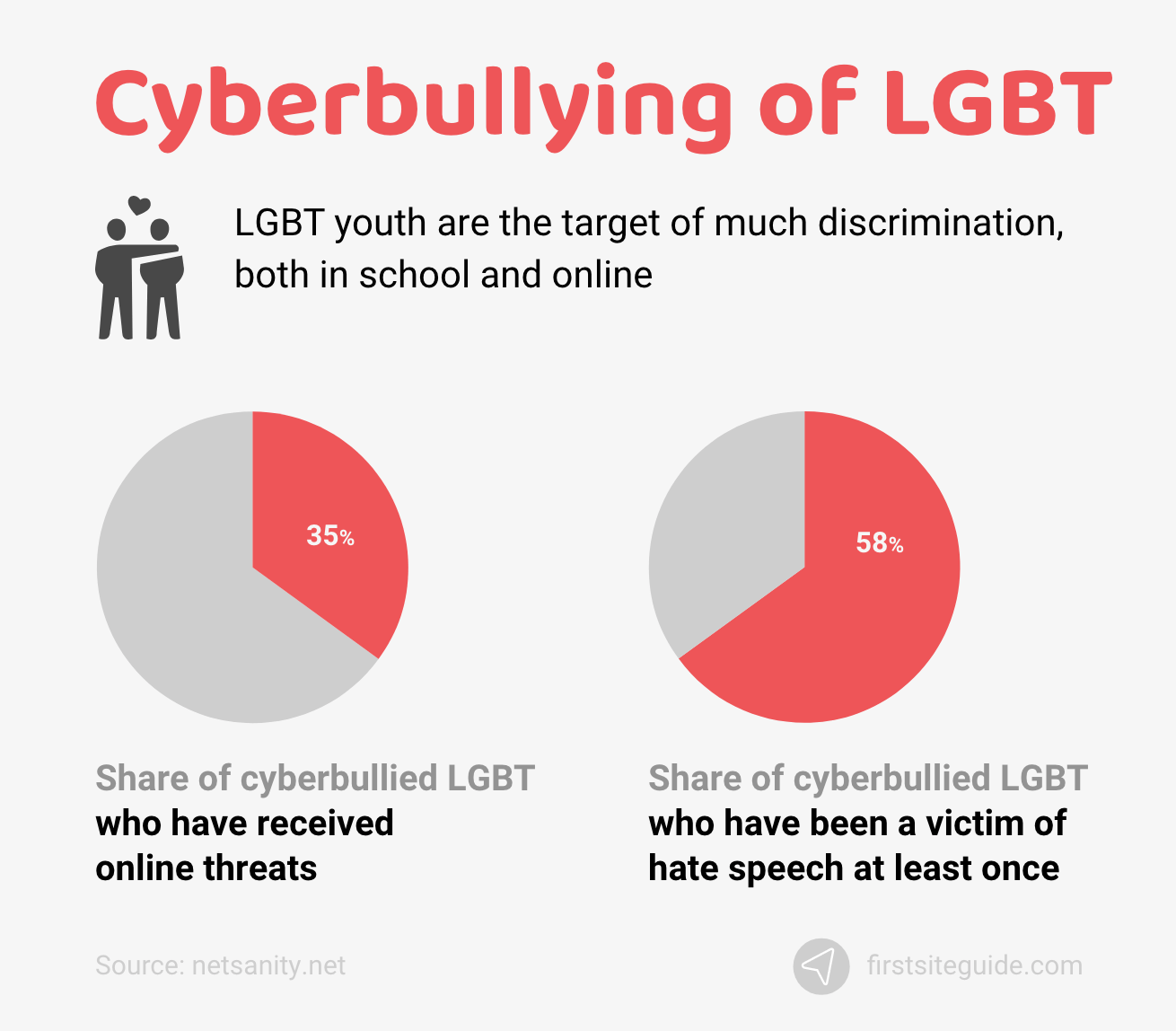
(Source: Netsanity.net)
Where are people cyberbullied?
There isn’t a single platform where all of the cyberbullying takes place, and no online space is completely free of cyberbullying. Since most children and young adults access the internet via their mobile devices, this is the most common medium through which they experience this type of harassment.
Cyberbullying statistics show that Instagram is the most common platform for cyberbullying, closely followed by Facebook and Snapchat. Many people experience cyberbullying while playing online multiplayer games as well. While YouTube is among the online platforms with the highest number of users, only a tenth of users have so far reported experiencing cyberbullying there.
15. 95% of teens in the U.S. are online, and the vast majority access the internet on their mobile device, making it the most common medium for cyberbullying.
With the growing use of mobile devices, the problem of cyberbullying in the US has increased. Teens have internet access pretty much everywhere, which makes it very easy for them to bully people online.
(Source: Dosomething.org)
16. More youths experienced cyberbullying on Instagram (42%) than on any other platform.
A recent survey shows that Facebook (37%) and Snapchat (31%) don’t lag far behind Instagram (42%), while there are fewer cases of cyberbullying on WhatsApp (12%), YouTube (10%), and Twitter (9%).
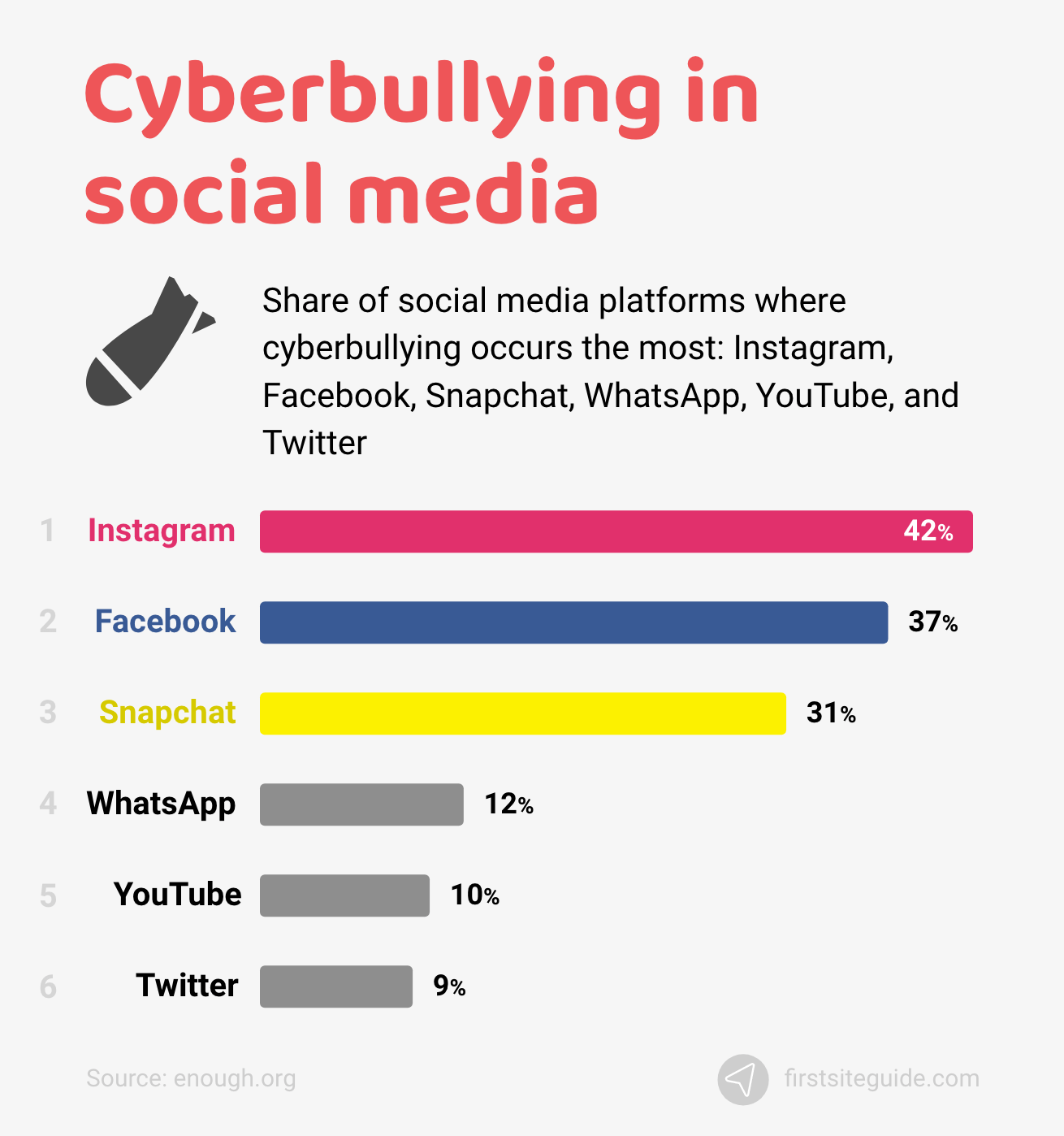
(Source: Enough.org)
17. Internet trolls are most active on social media.
According to Statista research, 38% of online trolls target people on social media, while 23% prefer trolling people on YouTube and other video-sharing platforms. They also often operate on forums, chat rooms, and blogs.
(Source: Statista.com)
18. Respondents with children who play online games reported a higher rate of cyberbullying attacks than those whose kids engage in only standard browsing activities.
79% of respondents reported their child receiving physical threats while playing games online, while 41% reported their child receiving sexist or racist remarks or experiencing name-calling through mean online comments.
(Source: Telenor.com)
19. What types of games do online bullies fancy most?
According to a Cyberbullying Research Center survey, gamers who prefer MMORPGs (26.8%) are more likely to engage in cyberbullying, followed by those who prefer third-person shooter (24.5%), first-person shooter (14.2%), and sports games (11.9%).
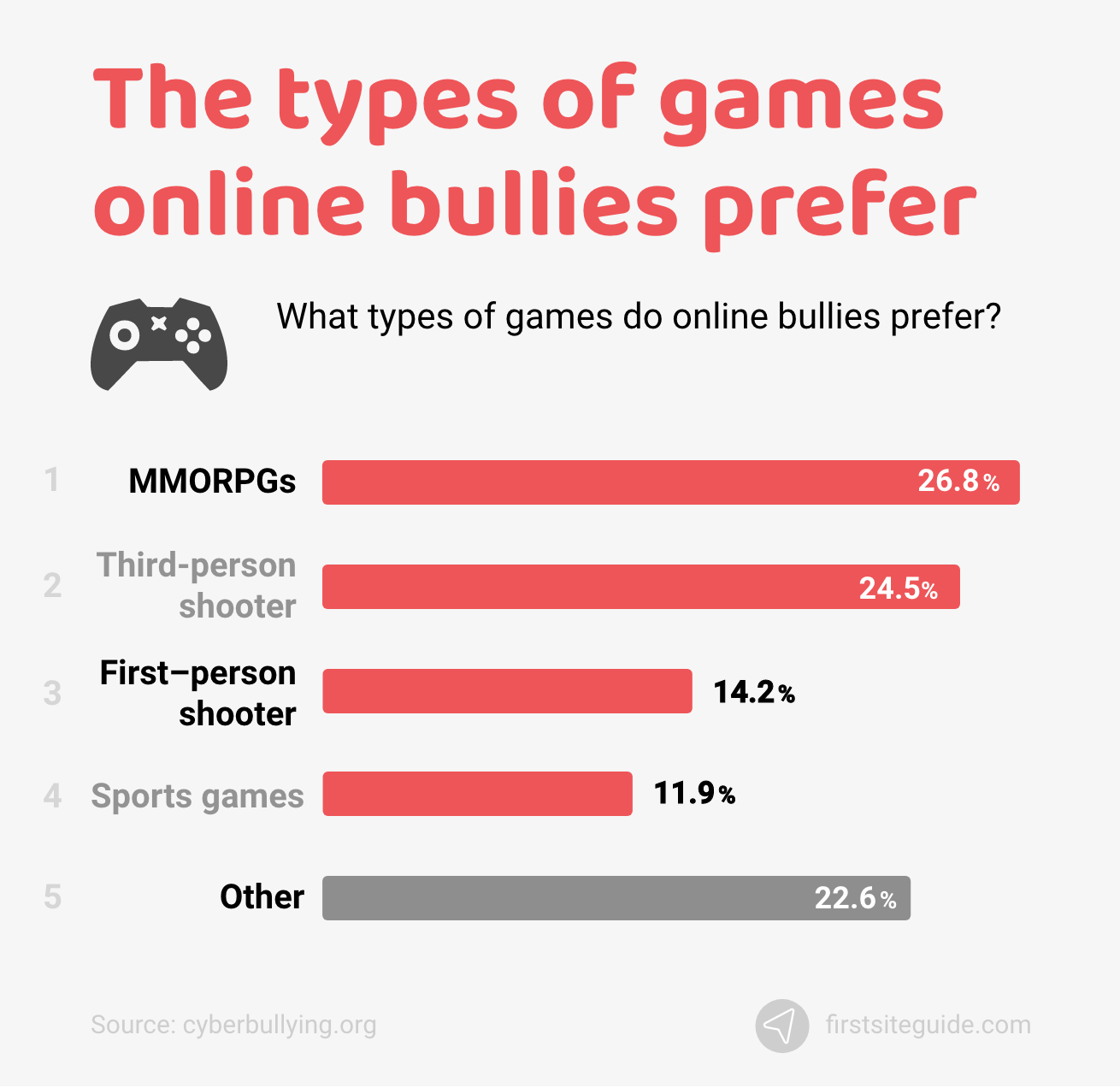
(Source: Cyberbullying.org)
Blogging bullying
With over 500 million blogs on the internet, it’s no wonder that bloggers are, in fact, one of the most common targets for cyberbullies. While the comment section is usually reserved for discussions and questions for the author, you’ll notice hateful and hurtful comments sometimes tend to be prevalent. The victim of blogging bullying isn’t only the author but includes many commenters as well.
The other side of blogging bullying is when the author of the blog themselves posts hateful content that’s intended to embarrass, insult, or otherwise upset someone else. While this is most prevalent among school children and students, it’s common among adults as well.
If you want to start a blog, keep these facts in mind.
Impacts of cyberbullying
Bullying as a whole has a huge impact on a victim’s mental wellbeing and their overall quality of life, and cyberbullying is no different. As a matter of fact, some studies suggest that bullies tend to be more aggressive online as there are rarely any real-world consequences of their actions, so the impact on the victims could potentially be even greater.
Victims of cyberbullying often experience much lower self-esteem, greater social anxiety, depression, and many experience suicidal thoughts as well.
Cyberbullying can be a cause of alcohol and drug abuse, eating disorders, poor school performance, and more. All this serves to show how harmful cyberbullying is and how important it is to put a stop to it.
20. More teen suicides are now attributed in some way to cyberbullying than ever before.
Between 2008 and 2015, the number of teens who attempted suicide or had suicidal thoughts has doubled, as revealed at the Pediatric Academic Societies Meeting of 2017. Many cases were the result of cyberbullying.
(Source: Pas-meeting.org)
21. Cyberbullying can have serious impacts on the self-esteem and mental health of people who experience it.
These alarming cyberbullying statistics show how enormous the negative impact of bullying is and how paramount it is to take strong measures to finally stop it. The overall health of targeted people depends on it. 41% of people who were cyberbullied developed social anxiety and 37% of them developed depression, while 26% even had suicidal thoughts.
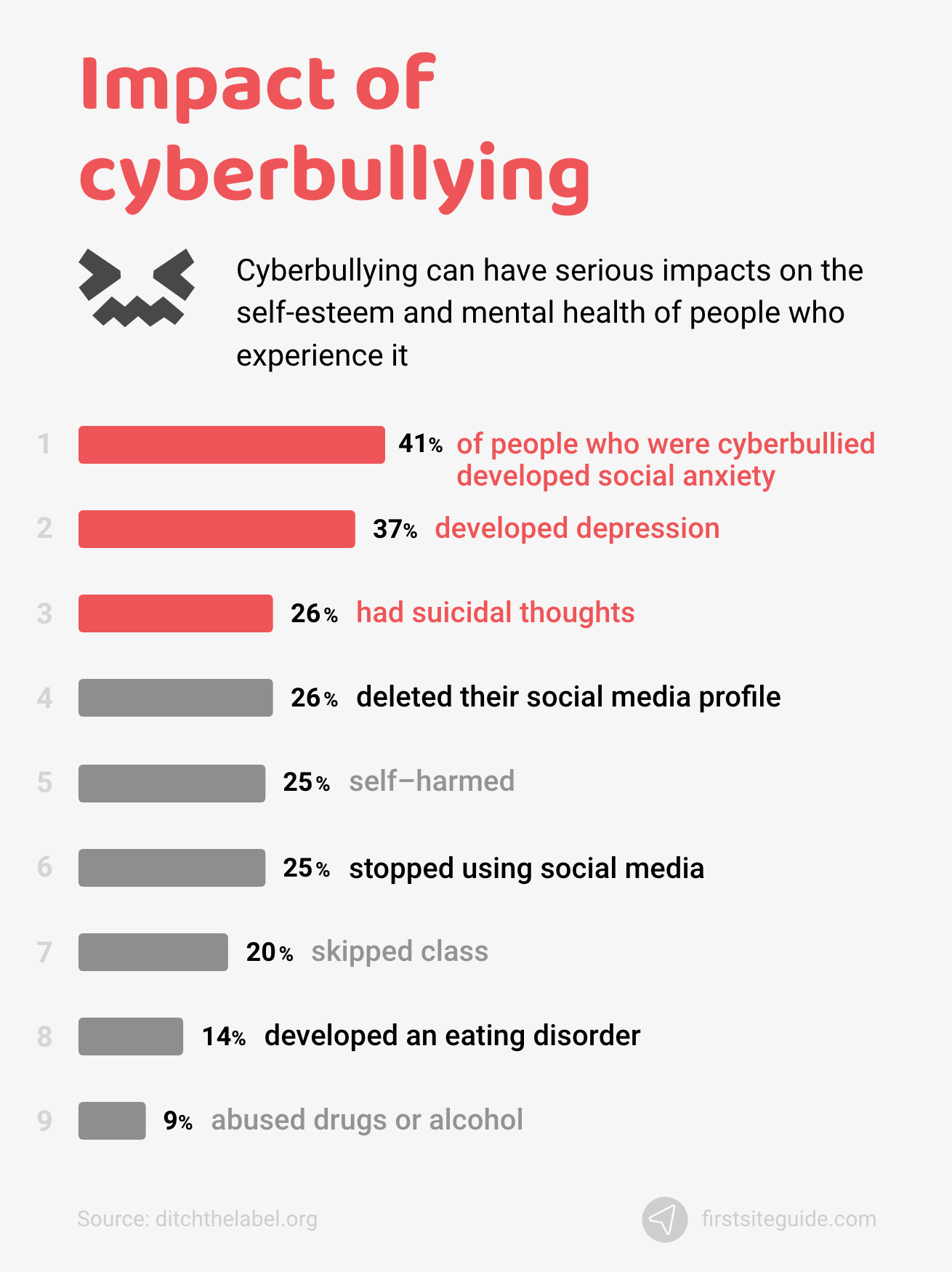
(Source: Ditchthelabel.org)
22. Research has found that children who are bullied are 9 times more likely to be the victims of identity fraud as well.
This was revealed in a 2017 worldwide study by Javelin Strategy & Research, which showed that there was a big connection between being bullied online and being a victim of identity theft afterward.
(Source: Javelinstrategy.com)
23. Data on the psychological impact of women experiencing online abuse or harassment worldwide.
According to a 2017 survey by Statista, a significant number of female victims of cyberbullying end up dealing with a range of negative effects on their mental health and overall well-being. 66% of cyberbullied women felt powerless in their ability to respond to the abuse while 63% of them couldn’t sleep well. Another significant negative effect due to cyberbullying is a loss of self-confidence, which was found in 61% of women.

(Source: Statista.com)
Cyberbullying around the World
Cyberbullying isn’t just a problem solely in the United States. It’s actually a global issue. The top 3 countries where cyberbullying is the most prevalent are India, Brazil, and the United States, but it is a common occurrence everywhere.
Social media cyberbullying statistics show that over 65% of parents around the world cite cyberbullying on social media as one of their greatest worries.
While many countries are trying to impose anti-bullying laws, an effective preventative measure still hasn’t been discovered, and residents of many countries aren’t satisfied with how bullying is being handled.
On the bright side, cyberbullying awareness is at an all-time high, meaning that governments around the world must take measures to prevent it.
24. Countries where cyberbullying was reported the most
India has recorded the highest rate of children falling victim to cyberbullying in 2018 so far. Over 37% of Indian parents have admitted that their children have been victims of cyberbullying at least once, which is 5% more than in 2016.
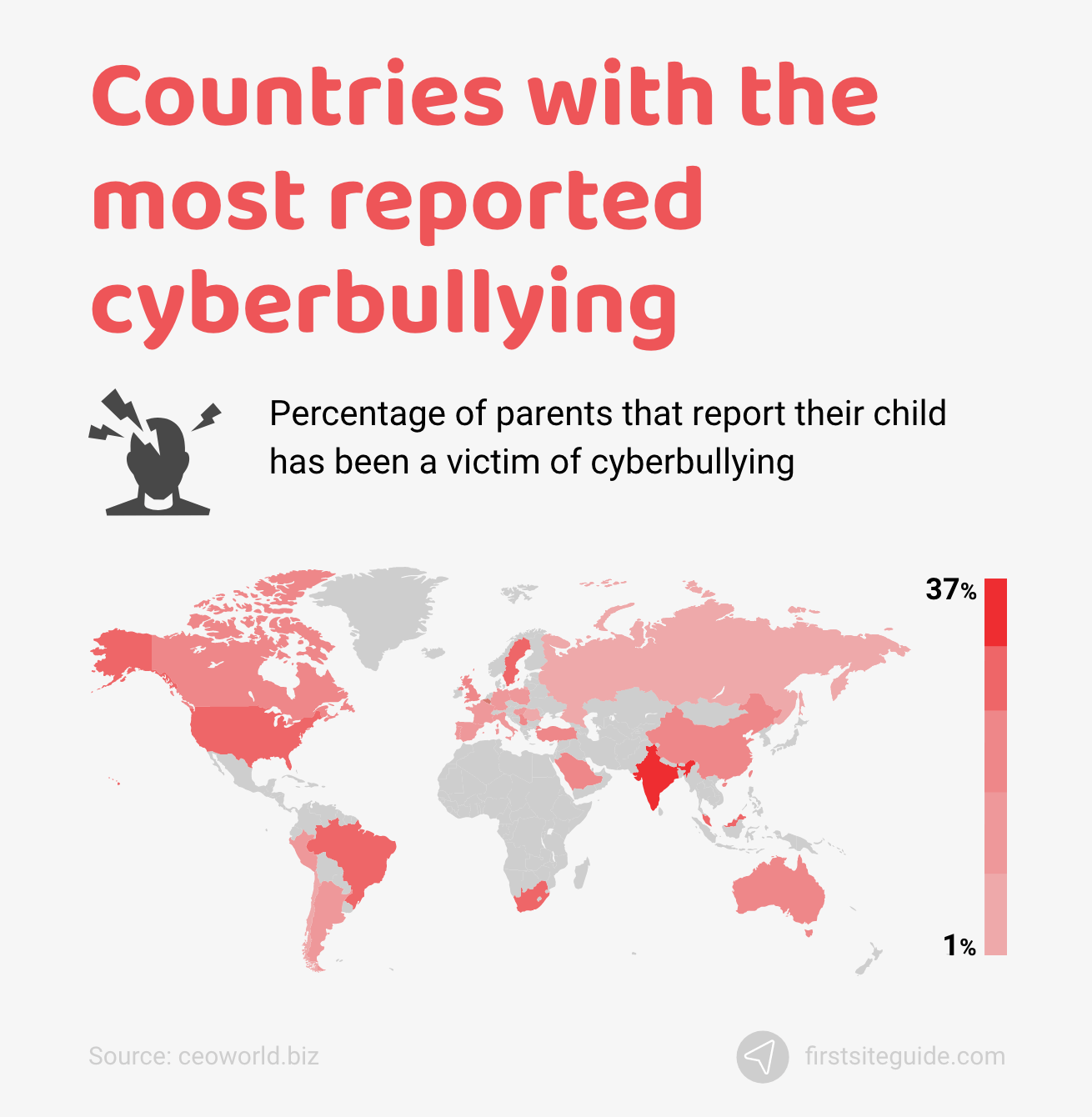
(Source: Ceoworld.biz)
25. Out of 30 countries, one in three young people state they have been a victim of online bullying, with one in five reporting having skipped school due to cyberbullying and violence.
These statistics were recently revealed by a UNICEF poll, raising even more concern about cyberbullying and calling for urgent action to finally end all forms of violence in schools and societies all over the world.
(Source: Unicef.org)
26. Nearly half of adolescents in the Philippines experience cyberbullying.
The national data from UNICEF reports a high cyberbullying rate in the Philippines. Nearly half of adolescents aged 13-17 have fallen prey to this digital scourge. The distribution is almost equal between genders, with males accounting for 44% and females 43% of the victims.
(Source: Unicef.org)
27. 65% of parents know a child in their household or community who had been cyberbullied through social media.
Out of 20,793 parents participating in worldwide research, the majority (65%) fear social media bullying for a good reason, as most cases do take place there, primarily on Instagram, Facebook, and Snapchat. Other common online threats include online messaging (38%) and chat rooms (34%).
(Source: Statista.com)
28. Global cyberbullying awareness is at 75%. Sweden and Italy are leading the chart with 91% awareness.
Cyberbullying awareness is on the rise, showing real promise of putting an end to this serious global problem. Cyberbullying facts and statistics show that Saudi Arabians are currently the least aware of cyberbullying (37%).

(Source: Statista.com)
Reactions to cyberbullying
While most people are aware of bullying and cyberbullying facts, few know how to deal with it. Those who are witnesses to it rarely react, mostly because they fear the repercussions of getting involved. Parents are often not aware that their child is being cyberbullied because most children believe this to be a normal occurrence and don’t want to let their parents know.
Most children attempt to stop cyberbullying by blocking the bullies on social media platforms, and so far, this seems to be their best option.
Luckily, 48 US states have introduced electronic harassment laws, and 44 of them include criminal sanctions for cyberbullying.
29. Google Trends data indicates much more attention is focused on cyberbullying than ever before.
People are becoming increasingly aware of this issue, which doesn’t come as a surprise, given that cyberbullying has been steadily growing for years. Anti-bullying laws have definitely helped raise awareness.

(Source: Google.com)
30. The website Nobullying.org recorded over 9.3 million visits in 2016 from people seeking help with bullying, cyberbullying, and online safety.
Websites like Nobullying.org have been more common in recent years, empowering people who experience any kind of bullying to seek help and regain control of their lives.
(Source: Nobullying.org)
31. The number of US states with state cyberbullying laws, by policy implementation:
Cyberbullying laws in the US vary by state and policy implementation. 48 states include cyberbullying and online harassment in their laws while 44 states include criminal sanctions for cyberbullying in their laws.
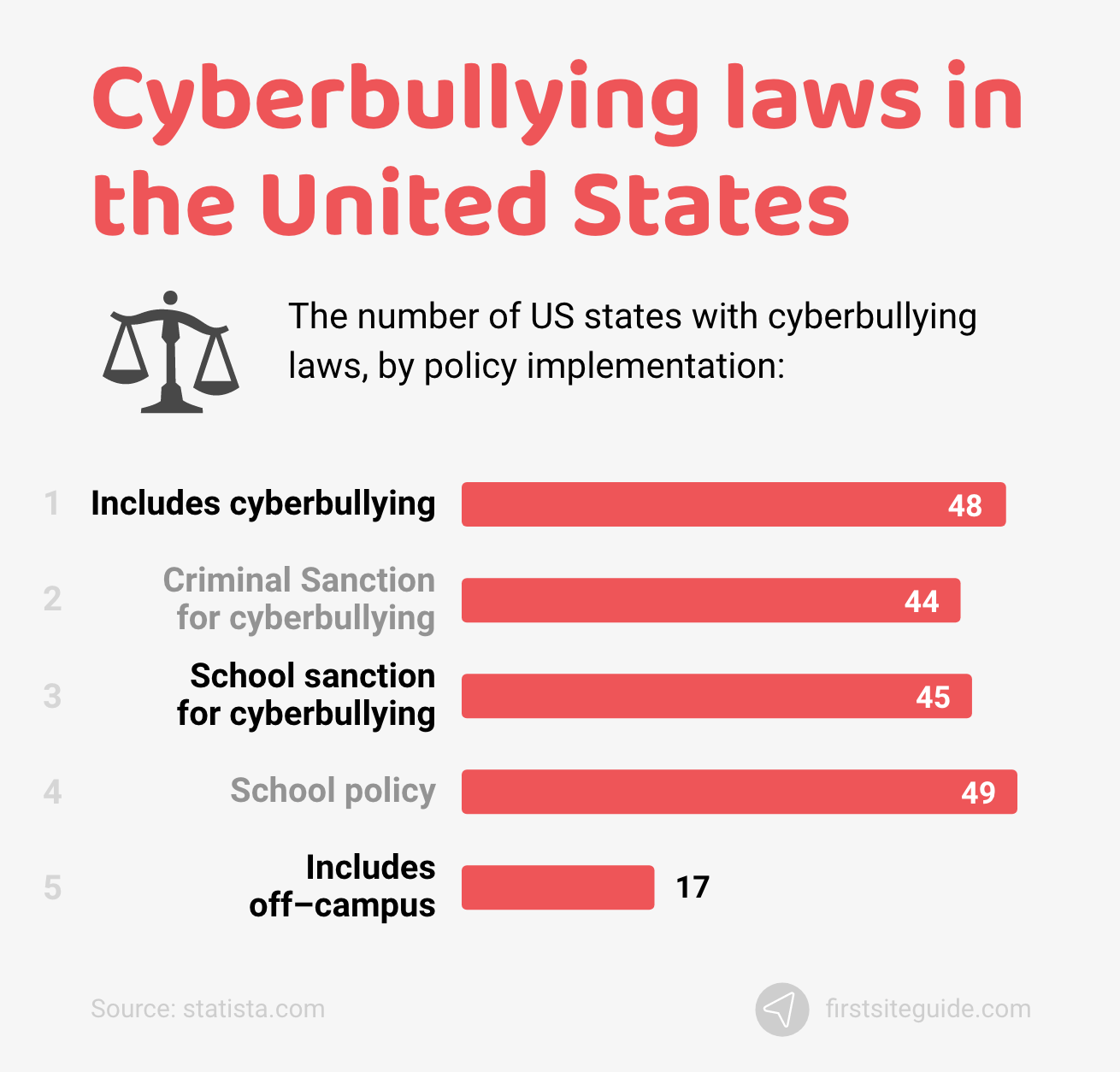
(Source: Statista.com)
32. 83% of young people believe social media companies should be doing more to tackle cyberbullying on their platforms.
As already discussed, generally the best option seems to be blocking bullies on social media, but that doesn’t prevent the bullies from spreading online rumors and using other types of online harassment.
(Source: Dosomething.org)
33. Frequency of talking about the internet and online behavior between parents and children.
According to a social media survey by Telenor Group, a lot of parents (46%) speak to their children frequently about online behavior and threats. However, some parents (39%) do it only sometimes, while others (12%) never do it.

(Source: Telenor.com)
34. 4 out of 5 students say they would be more likely to intervene in instances of cyberbullying if they could do it anonymously.
Most witnesses to cyberbullying don’t ever intervene, as they wouldn’t want the perpetrators to turn on them. However, if there was an anonymous way to do it, 81% of students say they would probably help the victims.
(Source: Dosomething.org)
35. Parents want to be involved in helping to prevent and solve cyberbullying but don’t know how.
The study also found that teens often believe cyberbullying is normal and don’t want parents to intervene. This is why we need to continue raising awareness about cyberbullying. Teens need to understand that it’s not normal, and every parent should have access to effective solutions against bullies.
(Source: Gromsocial.com)
36. 68% of US respondents confirm they are sharing less personal information online than before.
Children are also increasingly aware of the dangers of cyberbullying. Reducing personal information shared online is definitely one of the ways to prevent some forms of cyberbullying, such as blackmail. The fewer bullies know about someone, the less likely they are to harass them both online and offline.

(Source: Reportlinker.com)
37. Over 70% of teens say that blocking the account of the perpetrator was the most effective method for internet safety.
Before talking to their parents or seeking any help, most US teens block their bullies’ social media accounts. They believe it to be the best way to prevent cyberbullying.
(Source: Ncpc.org)
Conclusion
While the above-mentioned cyberbullying statistics and facts are frightening, there is a silver lining to the growing problem of cyberbullying. Governments around the world are trying to control and prevent cyberbullying, global awareness of the problem is on the rise, and many social media platforms are attempting to put a stop to cyberbullying as well.
As a final note, it’s important to teach the children about what cyberbullying is, what its impacts are, and how it can be prevented. As always, education is the only true solution.

I have the answer – I wrote a Book on it ten years ago. it is called Bullying Cure. The schools say-show us proof or we won’t implement it or even allow you to test it with volunteers. Meanwhile kids are committing suicide.
thank you, helped me with my project!
Awesome! We’re so glad we could help!
Thank you for writing an article to shed light on the bullying crisis.
Thanks for the Info! I really needed it for my report! 🙂
Glad we were able to help)
Nice Information!
Thanks Myron!
Thanks for sharing this valuable piece of content with us.
Thanks Kadam!
Thanks for sharing! Very interesting to read.
Thank you Rsuren!